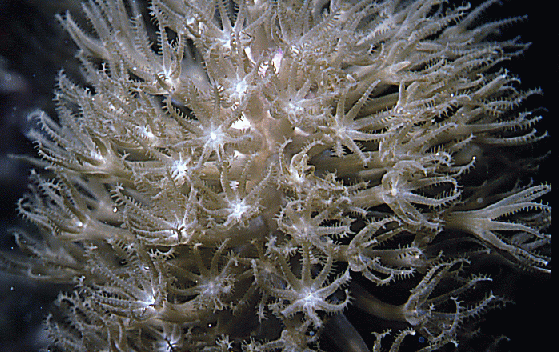Introduction to the Octocorallia

Although commonly called "soft corals," the Octocorallia are not
close relatives of the
Scleractinia,
or "true corals" living today. Unlike true corals, which have
hexaradial
symmetry, octocorals have eightfold radial symmetry -- count
the tentacles on the polyps of this Muricea, from the
Bahamas. Notice also that the tentacles of Muricea, like
those of all octocorals, are pennate -- small branches come off of
the main tentacle to give a more or less feather-like
appearance. All octocorals are colonial polyps, and in some, such as
the Pennatulacea or "sea pens," the polyps are specialized for
various functions.
Octocorals are traditionally divided into six orders:
- The Telestacea and Alcyonacea are two types of
"soft coral." Muricea, pictured above, is an alcyonacean
soft coral.
- The Stolonifera includes the so-called "organ-pipe corals."
- The Gorgonacea includes the sea fans and sea whips.
- The Pennatulacea includes the
sea pens and sea pansies.
- The Helioporacea includes only one genus, Heliopora, the
so-called "blue coral" of the Indian and Pacific Oceans.
Except for the "blue coral"
and "organ-pipe corals," few octocorals produce
substantial calcium carbonate skeletons; hence the name "soft coral"
for many of them. However, most octocorals form spicules within their
tissues, and some produce calcified holdfast structures or long, rodlike
internal supports; these parts can be preserved as fossils. Such fossils have
not received much study by paleontologists, but have been found at scattered
localities throughout the Phanerozoic. Rare fossils that preserve impressions
of the soft tissues of octocorals have been found in the
Cambrian Burgess Shale and elsewhere.
A searchable
bibliography of
the Octocorallia is now available from the
National Museum of
Natural History.









